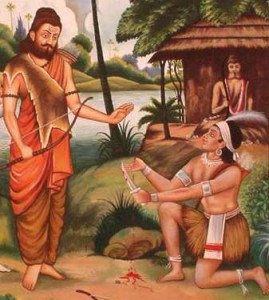
Ekalavya self-taught himself archery, so much so that he became the world’s best archer. When a renowned guru of archery discovered this he was not too happy. This is an ancient story that throws light on the guru-disciple relationship. When you understand this relationship you will understand the driving force behind Krishnamacharya’s actions.
The story of Ekalavya is from the time of Mahabharata the great Indian epic. Some scholars have dated this to around 3000 BC. In this period Dronacharya was a renowned teacher and guru. He had a school in the forest where he trained children of royal descent. Ekalavya came from a poor family and lived near Dronacharya’s school. He wanted to be an archer and learn from the famous guru himself.
When Ekalavya approached Dronacharya with a request that he accept him as his student, he was rebuffed. “My school is only for royalty. I cannot allow a commoner like you study in my school and mix with the royal kids,” Dronacharya told him.
Ekalavya was not easily dissuaded. Since archery is taught outdoors he hid in the bushes and observed Dronacharya teach. He then went back to his hut and practiced what he had learnt. He had built a statue of Dronacharya and practiced relentlessly in front of the statue. Due to his skill and dedicated effort he went on to become a very good archer.
One day when Ekalavya was resting in his hut the barking of a dog disturbed him. He skillfully shot multiple arrows into the mouth of the dog such that the dog was not hurt but his mouth was so stuffed with arrows that he was unable to bark. The surprised dog ran away with a mouthful of arrows stuffed in his mouth. Soon the dog ran into some students of Dronacharya. They were amazed to see such a fine example of skilled archery and took the dog to their guru.
Dronacharya realized that this was the work of a great archer and was anxious to look for him. He immediately set out into the forest and very soon came upon Ekalavya’s hut. When confronted Ekalavya confessed that he had learnt archery from him by hiding in the bushes and practicing by his statue. Dronacharya then said, “Since you admit that you learnt your skills from me, it means that you now owe me guru-dakshina!”
Guru-Dakshina is the way by which a guru is compensated by his students. This is done only after the study is over. A student is honor bound to comply with whatever guru-dakshina the guru asks for.
Ekalavya was thrilled to hear Dronacharya’s words. This meant that finally the great guru had accepted him as his student. He fell to the feet of the guru and said, “It will be my honor to fulfill your wishes, my master. Please tell me what you want!”
“Very well then,” Dronacharya said in a firm voice. “I need the thumb of your right hand!”
Ekalavya was stunned when he heard this. Giving up the thumb of his right hand would mean an end to his career as an archer. That is all he had dreamt of all his life. After his initial shock wore off, Ekalavya realized that being a great archer was secondary to his duties as a disciple. He immediately chopped off his thumb and laid it next to the feet of his guru.
It is said that Dronacharya had made a commitment to the king to make Arjuna, one of the prince studying under him, as the world’s best archer. He asked for Ekalavya’s thumb to make sure that he kept his commitment to the king. Ekalavya would otherwise have easily beat Arjuna in archery.
This was the beginning of the fall from grace for Dronacharya. In the ensuring war of Mahabharata Dronacharya found himself on the wrong side of the war. As a commander of the army he was completely outmaneuvered and eventually killed by a bit player. His side lost the war. History now remembers him, not as a great guru, but as a teacher of the princes who fought in the epic war of Mahabharata.
This story illustrates the burden a student feels in meeting’s a guru’s wishes in the guru-dakshina a guru asks for. When Krishnamacharya’s guru asked, as his guru-dakshina, that Krishnamacharya get married and devote his life to spread yoga, this is what he was honor-bound to do. This is why Krishnamacharya turned down many lucrative offers for religious posts or posts with Maharajas. He instead dedicated his life to popularize yoga in deference to his guru’s wish.
